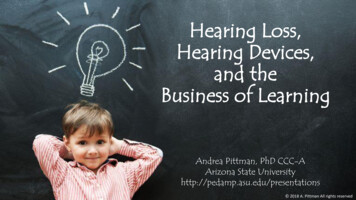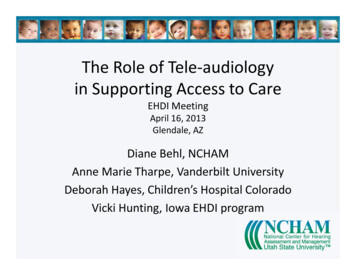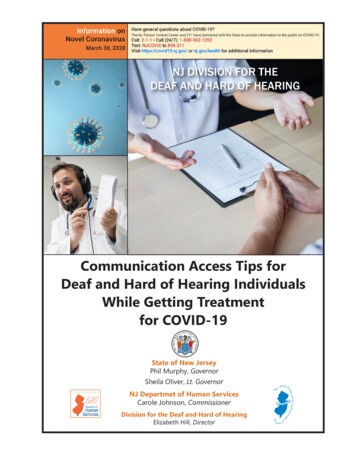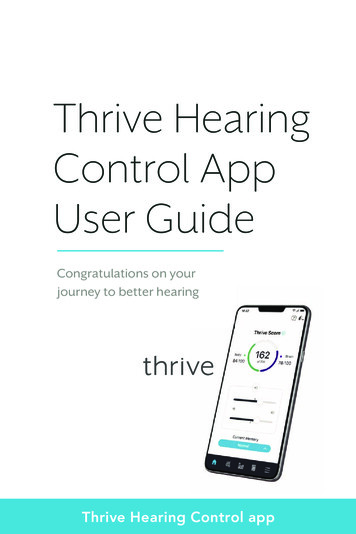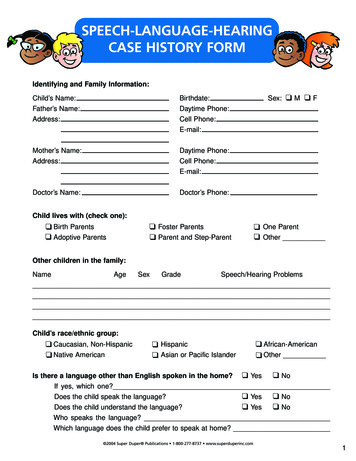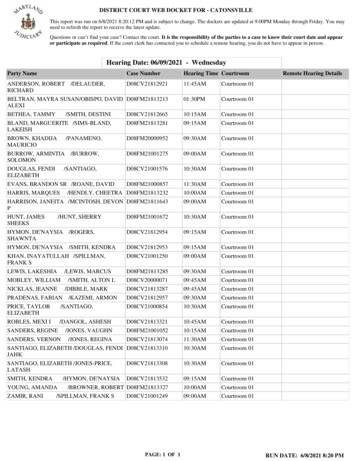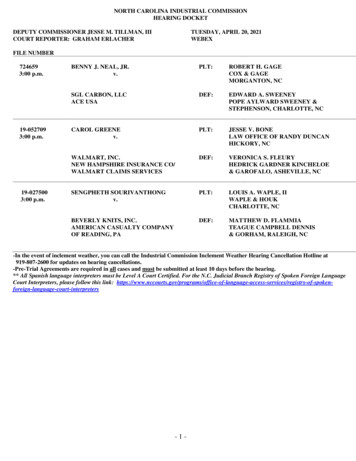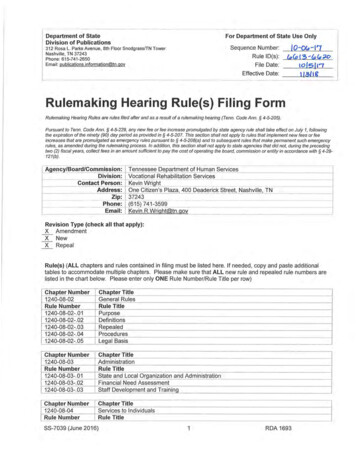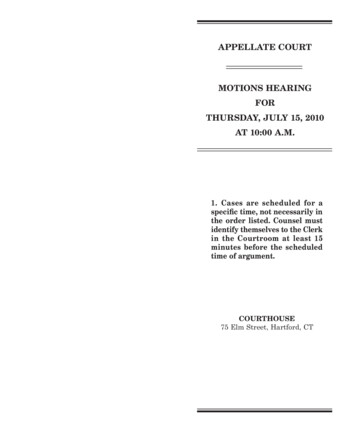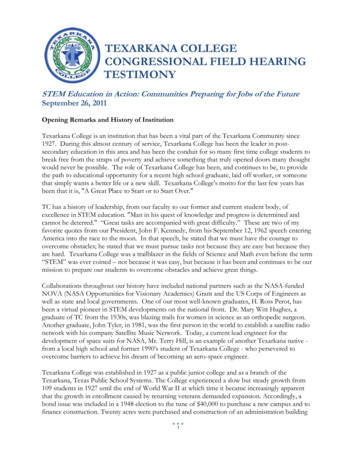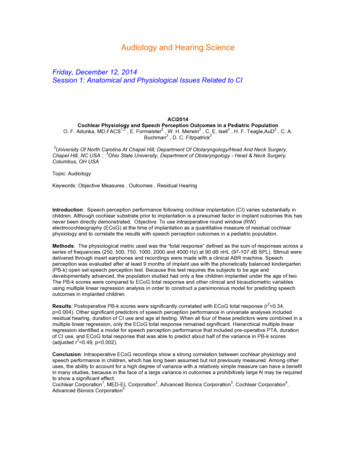
Transcription
Audiology and Hearing ScienceFriday, December 12, 2014Session 1: Anatomical and Physiological Issues Related to CIACI2014Cochlear Physiology and Speech Perception Outcomes in a Pediatric Population1,22222O. F. Adunka, MD,FACS , E. Formeister , W. H. Merwin , C. E. Iseli , H. F. Teagle,AuD , C. A.22Buchman , D. C. Fitzpatrick2University Of North Carolina At Chapel Hill, Department Of Otolaryngology/Head And Neck Surgery,3Chapel Hill, NC USA ; Ohio State University, Department of Otolaryngology - Head & Neck Surgery,Columbus, OH USATopic: AudiologyKeywords: Objective Measures , Outcomes , Residual HearingIntroduction: Speech perception performance following cochlear implantation (CI) varies substantially inchildren. Although cochlear substrate prior to implantation is a presumed factor in implant outcomes this hasnever been directly demonstrated. Objective: To use intraoperative round window (RW)electrocochleography (ECoG) at the time of implantation as a quantitative measure of residual cochlearphysiology and to correlate the results with speech perception outcomes in a pediatric population.Methods: The physiological metric used was the “total response” defined as the sum of responses across aseries of frequencies (250, 500, 750, 1000, 2000 and 4000 Hz) at 90 dB nHL (97-107 dB SPL). Stimuli weredelivered through insert earphones and recordings were made with a clinical ABR machine. Speechperception was evaluated after at least 9 months of implant use with the phonetically balanced kindergarten(PB-k) open set speech perception test. Because this test requires the subjects to be age anddevelopmentally advanced, the population studied had only a few children implanted under the age of two.The PB-k scores were compared to ECoG total response and other clinical and bioaudiometric variablesusing multiple linear regression analysis in order to construct a parsimonious model for predicting speechoutcomes in implanted children.2Results: Postoperative PB-k scores were significantly correlated with ECoG total response (r 0.34,p 0.004). Other significant predictors of speech perception performance in univariate analyses includedresidual hearing, duration of CI use and age at testing. When all four of these predictors were combined in amultiple linear regression, only the ECoG total response remained significant. Hierarchical multiple linearregression identified a model for speech perception performance that included pre-operative PTA, durationof CI use, and ECoG total response that was able to predict about half of the variance in PB-k scores2(adjusted r 0.49, p 0.002).Conclusion: Intraoperative ECoG recordings show a strong correlation between cochlear physiology andspeech performance in children, which has long been assumed but not previously measured. Among otheruses, the ability to account for a high degree of variance with a relatively simple measure can have a benefitin many studies, because in the face of a large variance in outcomes a prohibitively large N may be requiredto show a significant effect.1234Cochlear Corporation , MED-EL Corporation , Advanced Bionics Corporation , Cochlear Corporation ,5Advanced Bionics Corporation
ACI2014Electric Charge Requirements of Pediatric Nucleus Recipients with Normal and Abnormal Inner EarAnatomy11H. K. Slager,AuD , T. A. Zwolan, Ph.D.1University of Michigan, Otolaryngology, Ann Arbor, MI USATopic: Basic ResearchKeywords: Anatomy, Sound Processing, Speech CodingIntroduction: Little data exists regarding average psychophysical responses and the stability of theseresponses over time in children with normal or abnormal inner ear anatomy. One longitudinal study reportedthat pediatric programming levels vary significantly across programming centers. This highlights the need tocollect data to aid clinicians in programming difficult to test populations. Objective: The aim of this study wasto calculate mean electric charge requirements and charge variability over time in children with normal andabnormal inner ear anatomy.Methods: This study was a retrospective review of pediatric Nucleus device recipients at a large tertiarycare clinic who underwent surgery prior to 60 months of age. Subjects included children with normalor abnormal inner ear anatomy (Enlarged vestibular aqueduct (EVA), hypoplastic cochleae, incompletepartition type I or II, common cavity, and narrow internal auditory canals). Psychophysical measurementsanalyzed were threshold (T) and comfort (C) levels obtained at approximately 6 and 24 months postactivation. Threshold and comfort levels were converted to units of charge per phase (nC). Mean chargerequirement and variability over time was calculated for each anatomical subgroup. Mean chargerequirement for each subgroup was compared to data for children with normal anatomy and comparisonswere made across anatomical subgroups. Typical mapping parameters (strategy, pulse width, pulse rate,maxima), number of useable electrodes, sound field detection thresholds, and demographic information(pre-operative hearing thresholds, communication mode) for each subgroup were also analyzed andcompared.Results: Mean electric charge requirements and variability over time for pediatric Nucleus device recipientswith normal cochleae, EVA, hypoplastic cochleae, incomplete partition type I and II, common cavity, andnarrow internal auditory canals will be presented. Data analytics will include comparison of electric chargerequirements of each anatomical subgroup versus normal cochlear anatomy, and comparison of electriccharge requirements across anatomical subgroups. Typical mapping parameters and demographicinformation will be presented for each anatomical subgroup.Conclusion: The determination of programming levels (T/C levels) can be difficult to accomplish in somepatients, particularly in young children and children with abnormal cochlear anatomy. Furthermore, little datais available to aid clinicians in setting mapping parameters for children with abnormal cochlearanatomy. This study provides mean threshold and comfort levels for a large group of pediatric Nucleuscochlear implant recipients with normal or abnormal cochlear anatomy. This information is valuablebecause it provides data that may aid audiologists in the clinical management of these challenging groups ofpatients. More investigation is needed to correlate electric charge requirement with performanceoutcomes.123Cochlear Americas , MedEl Corporation Advanced Bionics Corporation
ACI2014The Effect of Bone Conduction Amplification on Speech and Language Abilities in Childrenwith Aural Atresia1J. Attaway, MA1Casa Colina Centers For Rehabilitation, Audiology, Pomona, CA USATopic: Rehabilitation/Educational AspectsKeywords: Children and Recommended Rehabilitation , Rehabilitation for ChildrenIntroduction: Currently there is no guideline regarding bone conduction amplification for children withunilateral aural atresia. Research has suggested that delayed treatment for hearing loss can result in speechand language impairments. The purpose of this study was to examine the relationship between boneconduction amplification use and speech and language delays in children with aural atresia.Methods: Male and female subjects, 16 total, were included in this study if they were between 3 and 6 yearsof age and had unilateral or bilateral conductive hearing loss due to aural atresia. All subjects underwent anaudiology exam, which included an analysis of pure tone air and bone conduction, with speech thresholdsfor each ear when possible using picture identification word recognition and tympanogram, and a speechand language evaluation using the Preschool Language Scale 4 to assess language skills and theExpressive and Receptive One-Word Picture Vocabulary Tests (EOWPVT, ROWPVT) for vocabulary skills.A parent or legal guardian completed the Children’s Outcomes Worksheet.Results: We found that subjects who were fit before the age of one show better compliance with use ofbone conduction amplification and exhibited fewer delays in speech and language abilities. Interestingly,among those with speech and language delays those with right-sided atresia had significantly more severedelays.Conclusions: Findings from this study highlight a relationship between side of atresia, time of first fit withbone conduction device, compliance in device use, and speech and language abilities in children withatresia. In an effort to obtain a larger sample size we are expanding the study to include additional subjectsfrom another southern California speech and hearing center.
ACI2014The Role of Hand-Dominance on Speech Intelligibility Performances in Patients with UnilateralCochlear Implantation11C. H. Raine, MD,BS,MS,FRCS , A. Goomany , M. S. Miah1Yorkshire Auditory Implant Service, Bradford, West Yorkshire United KingdomTopic: Rehabilitation/Educational AspectsKeywords: Speech and Language Development with CIIntroduction: Hand-dominance may define which ear is responsible for transmission of speech, musical andcognitive information. Efficacy of cochlear implantation (CI) is usually based on assessment of speechintelligibility performances. This can be influenced by a number of factors including patients age, aetiology ofdeafness, duration of deafness and cognitive function. Cerebral dominance has been suggested as animportant factor determining the side of implant surgery. Hand-dominance laterality is an indirectdeterminant of cerebral dominance. Literature is very limited on the role of hand-dominance on efficacy ofunilateral CI surgery. Objective: To evaluate the role of hand-dominance on the efficacy of CI in relation tothe side of implantation based on outcomes of speech intelligibility performances.Methods: Post-lingually deafened patients with unilateral CI were studied. Data was collated from electronicrecords and CI audit database. Patients were selected according to defined criteria. For uniformity, speechintelligibility performances were assessed pre and post-operatively using the Bamford-Kowal-Bench (BKB)sentences. For the purpose of this study, BKB scores at 12 months post-operatively wereanalyzed. Statistical analysis was conducted using the Statistical Package for the Social Sciences (version22.0.0).Results: 294 patients met the study inclusion criteria with a median age of 54 years (range 16 - 89 years).217 (73.8%) patients were right handed, 51 (17.3%) were left handed and 26 (8.8%) were excluded basedon hand-dominance alone (could not be assessed or mixed-handedness). Overall, 67% of patients had CIon the dominant hand side and 33% on the non-dominant side for various reasons including patientpreference and clinical decision due to previous middle ear/mastoid surgery on the dominant side. Themean post-operative BKB scores were 78% (right-sided CI, right-dominant), 83% (left-sided CI, leftdominant), 69% (left-sided CI, right-dominant) and 76% (right-sided CI, left-dominant). However, there wasno statistically significant difference between the groups (Kruskall-Wallis H 6.93, Chi-square p 0.074163,p 0.05). Interestingly, there is significant difference in post-operative BKB scores between dominant sidedversus non-dominant sided CI in male patients (n 91, 87% vs n 51, 71%, p 0.0381) in contrast to femalepatients (n 89, 74% vs n 37, 81%, p 0.0843), respectively. On univariate and multivariate analysis nosignificant difference noted between dominant and non-dominant sides of implantation (p 0.079 andp 0.471, respectively).Conclusions: Hand-dominance is an important factor for decision making with regards to the side of CI frompatient’s perspective. However, from this study, it does not appear to affect the efficacy of CI assessed usingthe BKB sentences for speech intelligibility performances. These findings may be of some use in themanagement of children identified for unilateral CI surgery
ACI2014Auditory Brainstem Development in Children Receiving Different Devices In A SimultaneousBilateral Implant ProcedureStephanie. Jewell, BS1,Blake. C. Papsin, MD,BS,MS 1,2,Sharon. L. Cushing, MD,BS,MS 1,2, Karen. A. Gordon,BS,MS,Ph.D 1,2,3123Hospital For Sick Children, University of Toronto, University of TorontoTopicAudiologyKeywordsObjective MeasuresIntroduction: Simultaneous bilateral cochlear implantation has been shown to support symmetricdevelopment of the auditory brainstem when the same device is used bilaterally.Objective: In the present study, we asked whether auditory brainstem development would be affected byimplantation of two different electrode arrays: a pre-curved array and a straight array with the same receiverstimulator.Methods: Twenty-eight children were implanted with a pre-curved array in one ear and a straight array fromthe same manufacturer in the other in the same surgery. Electrically evoked auditory brainstem responses(EABRs) were collected at three time-points: the first week post-activation, 3 to 6 months post-activation,and 9 to 12 months post-activation. EABRs were evoked by biphasic single pulses delivered at 11Hz fromthe apical electrode (#20) and measured at a midline cephalic location (Cz) referenced to each earlobe inseparate recording channels. Stimuli were provided at levels which were comfortably loud and evokedequal amplitude wave eV amplitudes (peak to trough) from each side. Wave eV latencies and amplitudeswere marked and analyzed using repeated measures ANOVAs for time, device and eareffects. Results: Stimulus protocols resulted in consistent EABR wave eV amplitudes which did notsignificantly differ between devices (p 0.05) or change over time (p 0.05). EABR eV latency, on the otherhand, significantly decreased between initial measures (p 0.05) and follow up measures with no effects ofdevice or which ear was implanted with the straight array (p 0.05).Conclusion: Despite the use of two different devices, children receiving bilateral cochlear implantssimultaneously show symmetric auditory brainstem development during initial stages of implant use. Furtheranalysis of this group will determine whether brainstem development varies with residual hearing andsurgical approach.
ACI2014Etiology of Single Sided Deafness in Children with Congenital and Acquired Unilateral Deafness1111R. L. Beck,Dr. med. , S. Arndt,Prof. Dr. , A. Aschendorff,Prof. Dr. , F. Hassepa Dr. med. , T. Wesarg,Dr.11ing. , R. Laszig,Prof. Dr. Dr. h.c.1Medical Center - University Of Freiburg, Department Of Oto-Rhino-Laryngology, Freiburg, GermanyTopic: Surgery/MedicalKeywords: New Indications, Young and Very Young Children , Inner Ear MalformationIntroduction: Cochlear implantation in adults affected by single sided deafness or asymmetric hearing lossis on its way to become a standard of care due to the positive outcome documented. The effect of treatmentof the same disorder in children is still very unclear. The incidence of single sided deafness in children isestimated between 0.04 to 5 % dependent on the age of hearing loss (congenital or peri-/postlingual) andthe spectrum of causative mechanisms is decisively different compared to adults. Previous studies found adeficiency of the auditory nerve (hypoplasia or aplasia) in up to 18% of patients with bilateral deafness. Theaim of this study was to evaluate the etiology in children with congenital and acquired SSD.Methods: 42 children presenting at a tertiary referral center 2009-2014 with congenital (n 20) or acquired(n 22) unilateral deafness have been evaluated for cochlear implantation by electrophysiology (BERA,electrocochleography, promontory test where applicable), audiometry and imaging (MRI, CT). Rehabilitationby cochlear implantation has been performed, where agreed on by the legal guardians after extensivecounseling and if medically reasonable.Results: The age at time of presentation varied greatly and ranged from 2-15.6 years for children withcongenital unilateral deafness and 4.9-18 years for acquired SSD (time of deafness 0.3-10 years). This isnoteworthy as we should be able to detect children with congenital unilateral deafness reasonably early byNHS. 13 out of 20 congenitally deaf children show a hypoplastic or aplastic cochlear nerve and were notdeemed to be good candidates for rehabilitation by CI, CMV-infections where described in 3 children. Thecausative agents were much more diverse in 22 children with acquired deafness: In 5 cases, a EVAsyndrome could be found, 4 suffered from labyrinthitis, 3 from mumps. 4 out of 4 guardians of eligiblecongenital deaf children opted for CI (all have been implanted), 19 of 20 eligible children with acquireddeafness opted for CI (12 have been implanted; others are in the process to be implanted).Conclusion: Analysis of CT and MRI scans is essential to diagnose the cause of unilateral deafness. Thisholds true especially for children with congenital unilateral deafness as a very high percentage showcochlear nerve deficiency. If rehabilitation by cochlear implant is an option to be considered, diagnosis andcounseling have to occur at an earlier age to yield optimal results.
ACI2014Cochlear Implantation in Inner Ear Anomalies11M. Z. OZUER, MD , A. HANCER1Sifa University Medical Faculty, Otorhinolaryngology, Izmir, TurkeyTopic: Surgery/MedicalKeywords: Inner Ear Malformation, Medical/Surgical IssuesIntroduction: In the past, CI in certain inner ear anomalies was used to be a contraindication, it has beendetermined that these group of children benefit from CI. However, surgical risk factors and outcome of thechildren need to be counseled with the parents.Objective: To differentiate various inner ear anomalies with the aid of CT and MRI. Selection of electrodearray and planning surgery. To manage possible surgical complications.Methods: The inner ear anomalies encountered were large vestibular aquaduct (LVA), incomplete partitiontype I (IP-I) incomplete partition type II (IP-II), hypoplastic cochlea. Temporal CT and MRI were studied toidentify the anomalies.Results: In IP-I patients we encountered severe gusher, in IP-II patients and LVA patients we encounteredoozing of CSF. The presence of these group of anomalies introduce additional risks of surgery and potentialcomplications. Therefore, it is important to diagnose the anomaly. At the same time, the benefit of CI inthese group of patients limited.Conclusion: Our experience, in inner ear anomalies surgical results, complications and hearing outcomeswill be discussed. The selection of electrode, CSF management, facial nerve course need to be plannedbefore surgery.
Session 2: Combining Electric and Acoustic Stimulation: Binaural Hearing and/orHearing PreservationACI2014Bimodal Stimulation in Infants: Is There a Benefit to Language Development?11A. C. Moberly , S. Nittrouer1Ohio State University, Otolaryngology, Columbus, OH USATopic: Rehabilitation/Educational AspectsKeywords: Children and Recommended Rehabilitation, Speech and Language Development with CIIntroduction: Simultaneous bilateral cochlear implantation is increasingly being performed in infants withprofound sensorineural hearing loss, with the assumption that bilateral electric hearing will optimizelanguage outcomes. However, many of these children likely have some low-frequency residual hearing thatmay benefit from a period of bimodal stimulation (cochlear implant with contralateral hearing aid). Thispresentation will review for clinicians the theoretical underpinnings of language development that maybenefit from bimodal stimulation. Language development data from an ongoing longitudinal study of childrenwho received cochlear implants will be presented.Methods: Fifty-five children who received cochlear implants while under the age of 3 years wereincluded. Language development data were examined for these children, now having just finished secondgrade (age 8 ½ years). Twenty-six of these children experienced at least one year of bimodal stimulationaround the time of receiving their implants. All children were assessed usi
audiology exam, which included an analysis of pure tone air and bone conduction, with speech thresholds for each ear when possible using picture identification word recognition and tympanogram, and a speech and l
